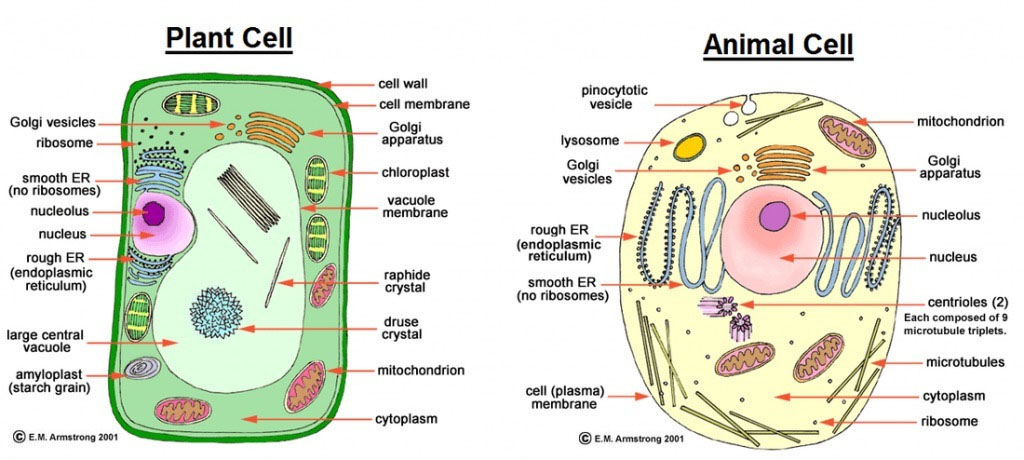Difference Between Plant Cell and Animal Cell

Plant Cell vs Animal Cell
Plant cells and animal cells have several structural differences, but they also have many similarities. Both animal cells and plant cells are eukaryotic cells, that is the reasons for the similarities such as the presence of cell membrane and some cell organelles. Before going ahead and understanding the difference between animal and plant cells, let us know what a cell is.
Definition of Cell
A cell is the smallest and fundamental unit of life. In unicellular and multicellular organisms, the cell is also referred to as a structural and functional unit of life. Cells are often known as ‘the building blocks of life’.
Comparison chart displaying the difference between the plant cell and animal cell
| Characteristics | Animal Cell | Plant Cell |
| Cell Wall | Absent | Present |
| Cell Shape | Mostly round, irregular and smaller than plant cells | Rectangular with distinct edges |
| Energy | Store energy in the form of complex carbohydrates and glycogen | Store energy as starch |
| Plasma Membrane | Present | Present |
| Vacuole | One or more small vacuoles | One large central vacuole |
| Centrioles | Present | Present only in lower plant forms (e.g. Chlamydomonas) |
| Chloroplast | Absent | Present |
| Cytoplasm | Present | Present |
| Endoplasmic reticulum | Present | Present |
| Nucleus | Present | Present |
| Lysosomes | Occurs in cytoplasm | Usually not very evident |
| Ribosomes | Present | Present |
| Mitochondria | Present | Present |
| Plastids | Absent | Present |
| Centrosomes | Present | Present |
| Golgi Apparatus | Present | Present |
| Peroxisomes | Present | Present |
| Cilia | Present | Most plant cells do not have cilia |
| Microfilaments/Microtubules | Present | Present |
| Flagella | Present in some cells | Present in some cells |
| Essential nutrients | Animal cells can synthesize amino acids, vitamins, and coenzymes | Plant cells cannot synthesize amino acids, vitamins, and coenzymes |
In the ecosystem, the plant has the role of producers while animals have taken the role of consumers. There characteristics and functions vary to a large extent, so do their cell structure. Let’s understand the difference between the structure and component of plant and animal cells in details.

Cell Wall
The most evident difference between a plant cell and an animal cell is the cell wall. Plant cells have a hard and rigid cell wall surrounding the cell membrane. Animal cells do not have a cell wall; instead, it is surrounded by a thin and flexible plasma membrane.
Cell Shape
The shape of the plant cell is rectangular with distinct edges, whereas animal cells come in many different shapes and sizes. The shape of the animal cells is evolved according to the various functions they perform in the body. The plant cell is larger in comparison to the animal cell. The normal range of plant cell is from 10 to 100 micrometres, whereas animal cell is from 10-30 micrometres.
Vacuoles
Animal cells may have more than one small vacuoles. In plant cells vacuoles are large, and that can take up to 90% of cell volume. Vacuoles in plant cells provide structural and functional support to the cell, like waste disposal, protection, storage and growth.
Centrioles
All animal cells have centrioles, whereas only lower plant cells have them. Some of the plants which have centrioles in their cell are Chlamydomonas, charophytes, bryophytes, cycads, and gingko.
Chloroplast
Chloroplast performs a crucial function of photosynthesis in plants. Animal cells do not have chloroplast in them.
Plastids
Plastids are absent in animal cells. In plant cells, plastids are double-membrane sac-like organelles, which are needed for photosynthesis.
Centrosomes
Both plant and animal cells have centrosomes and perform a similar function of cell division and include the collection of microtubules. However, the plant cell centrosomes are simpler and do not have centrioles.
Cilia
Cilia is absent in plant cell. Animal cells have distinct microtubules called cilia which help in cellular locomotion.
Lysosomes
The lysosomes are present in animal cells which carries enzymes that digest cellular macromolecules. Lysosomes are rarely present in plant cells as plant vacuoles handle molecule degradation.
So, it is quite clear now that animal and plant cells are significantly different from each other, even after having certain similarities. Plants and animals have evolved to create energy in a very different way, which has led to the structural and functional differences between the two.
This section will help you in answering the following question in the examination:
- What is the main difference between a plant cell and an animal cell?
- Are vacuoles present in animal cells?
- Do animal cells have a cell wall?
- Why are plant and animal cells different?
- Which cell organelle is responsible for carrying out photosynthesis in a plant cell?
- Name some cell organelles present only in animal cells?
- What is the function of the vacuole in the plant cell?
To know more about plant cell vs animal cell, you can join our Demo Class for Biology.
You can also check our Online Tuition for CBSE Biology, ICSE Biology, and ISC Biology.

